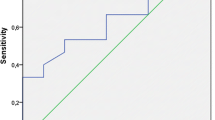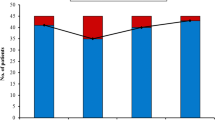Abstract
To investigate the predictive utility of stimulation threshold (ST) of intraoperative electromyography monitoring for facial nerve (FN) outcomes among vestibular schwannoma (VS) patients postoperatively. The authors enrolled 103 unilateral VS patients who underwent surgical resection into a prospective cohort observational study from January 2013 to April 2015 in our hospital. ST values were used to categorize 81 patients into the “low current” (ST ≤ 0.05 mA) group and 22 patients into the control (ST > 0.05 mA) group. The FN function outcomes were summarized and correlated with these two groups at 1, 3, 6, and 12 months after surgery. Binary regression analysis revealed that the percentage of “good” FN outcome, defined by House-Brackmann (HB) classification of facial function (I–II), in the “low current” group was significantly higher than that of the control group (42.0 vs. 4.5% at 1 month, P = 0.015; 64.2 vs. 31.8% at 3 months, P = 0.024; 72.8 vs. 40.9% at 6 months, P = 0.021; 84.0 vs. 45.5% at 12 months, P = 0.002). Ordinal regression analysis showed that the distribution of HB scores was shifted in a favorable direction in the “low current” group at 1, 3, 6, and 12 months postoperatively. For patients with HB IV at the first month postoperative period, the recovery rate of the “low current” group was significantly higher than that of control group (P = 0.003). “Low current” can predict FN function outcomes better and has faster recovery rates than that of the control group.



Similar content being viewed by others
Abbreviations
- CI:
-
Confidence intervals
- EMG:
-
Electromyography
- FN:
-
Facial nerve
- HB:
-
House-Brackmann classification of facial function
- MRI:
-
Magnetic resonance imaging
- OR:
-
Odds ratios
- ST:
-
Stimulation threshold
- VS:
-
Vestibular schwannoma
References
McClelland S 3rd, Kim E, Murphy JD, Jaboin JJ (2017) Operative mortality rates of acoustic neuroma surgery: a national cancer database analysis. Otol Neurotol 38:3. https://doi.org/10.1097/MAO.0000000000001362 751–753.
Liu SW, Jiang W, Zhang HQ, Li XP, Wan XY, Emmanuel B, Shu K, Chen JC, Chen J, Lei T (2015) Intraoperative neuromonitoring for removal of large vestibular schwannoma: facial nerve outcome and predictive factors. Clin Neurol Neurosurg 133:83–89. https://doi.org/10.1016/j.clineuro.2015.03.016
Prell J, Strauss C, Rachinger J, Alfieri A, Scheller C, Herfurth K, Rampp S (2014) Facial nerve palsy after vestibular schwannoma surgery: dynamic risk-stratification based on continuous EMG-monitoring. Clin Neurophysiol 125:415–421. https://doi.org/10.1016/j.clinph.2013.07.015
Huang X, Xu M, Xu J, Zhou L, Zhong P, Chen M, Ji K, Chen H, Mao Y (2017) Complications and management of large intracranial vestibular schwannomas via the retrosigmoid approach. World Neurosurg 99:326–335. https://doi.org/10.1016/j.wneu.2016.12.055
Huang X, Xu J, Xu M, Chen M, Ji K, Ren J, Zhong P (2017) Functional outcome and complications after the microsurgical removal of giant vestibular schwannomas via the retrosigmoid approach: a retrospective review of 16-year experience in a single hospital. BMC Neurol 17:18. https://doi.org/10.1186/s12883-017-0805-6
Silva J, Cerejo A, Duarte F, Silveira F, Vaz R (2012) Surgical removal of giant acoustic neuromas. World Neurosurg 77:731–735. https://doi.org/10.1016/j.wneu.2011.08.019
Sughrue ME, Yang I, Rutkowski MJ, Aranda D, Parsa AT (2010) Preservation of facial nerve function after resection of vestibular schwannoma. Br J Neurosurg 24:666–671. https://doi.org/10.3109/02688697.2010.520761
Samii M, Gerganov VM, Samii A (2010) Functional outcome after complete surgical removal of giant vestibular schwannomas. J Neurosurg 112:860–867. https://doi.org/10.3171/2009.7.JNS0989
Yingling CD, Gardi JN (2008) Intraoperative monitoring of facial and cochlear nerves during acoustic neuroma surgery. Neurosurg Clin N Am 19:289–315. https://doi.org/10.1016/j.nec.2008.02.011 vii.
Nissen AJ, Sikand A, Curto FS, Welsh JE, Gardi J (1997) Value of intraoperative threshold stimulus in predicting postoperative facial nerve function after acoustic tumor resection. Am J Otol 18:249–251
Duarte-Costa S, Vaz R, Pinto D, Silveira F, Cerejo A (2015) Predictive value of intraoperative neurophysiologic monitoring in assessing long-term facial function in grade IV vestibular schwannoma removal. Acta Neurochir 157:1991–1997.(discussion 1998). https://doi.org/10.1007/s00701-015-2571-9
Tokimura H, Sugata S, Yamahata H, Yunoue S, Hanaya R, Arita K (2014) Intraoperative continuous monitoring of facial motor evoked potentials in acoustic neuroma surgery. Neurosurg Rev 37:669–676. https://doi.org/10.1007/s10143-014-0561-7
Ashram YA, Badr-El-Dine MM (2014) Multichannel facial nerve monitoring: value in detection of mechanically elicited electromyographic activity and prediction of postoperative outcome. Otol Neurotol 35:1290–1297. https://doi.org/10.1097/mao.0000000000000441
Verst SM, Sucena AC, Maldaun MV, Aguiar PH (2013) Effectiveness of C5 or C6-Cz assembly in predicting immediate post operative facial nerve deficit. Acta Neurochir 155:1863–1869. https://doi.org/10.1007/s00701-013-1806-x
Oh T, Nagasawa DT, Fong BM, Trang A, Gopen Q, Parsa AT, Yang I (2012) Intraoperative neuromonitoring techniques in the surgical management of acoustic neuromas. Neurosurg Focus 33:E6. https://doi.org/10.3171/2012.6.focus12194
Hone SW, Commins DJ, Rames P, Chen JM, Rowed D, McLean A, Nedzelski JM (1997) Prognostic factors in intraoperative facial nerve monitoring for acoustic neuroma. J Otolaryngol 26:374–378
Grayeli AB, Guindi S, Kalamarides M, El Garem H, Smail M, Rey A, Sterkers O (2005) Four-channel electromyography of the facial nerve in vestibular schwannoma surgery: sensitivity and prognostic value for short-term facial function outcome. Otol Neurotol 26:114–120
Mandpe AH, Mikulec A, Jackler RK, Pitts LH, Yingling CD (1998) Comparison of response amplitude versus stimulation threshold in predicting early postoperative facial nerve function after acoustic neuroma resection. Am J Otol 19:112–117
Shamji MF, Schramm DR, Benoit BG (2007) Clinical predictors of facial nerve outcome after translabyrinthine resection of acoustic neuromas. Clin Invest Med 30:E233–E239
Neff BA, Ting J, Dickinson SL, Welling DB (2005) Facial nerve monitoring parameters as a predictor of postoperative facial nerve outcomes after vestibular schwannoma resection. Otol Neurotol 26:728–732
House JW, Brackmann DE (1985) Facial nerve grading system. Otolaryngol Head Neck Surg 93:146–147
Samii M, Matthies C (1997) Management of 1000 vestibular schwannomas (acoustic neuromas): the facial nerve-preservation and restitution of function. Neurosurgery 40:684–694 (discussion 694–685)
Isaacson B, Kileny PR, El-Kashlan H, Gadre AK (2003) Intraoperative monitoring and facial nerve outcomes after vestibular schwannoma resection. Otol Neurotol 24:812–817
Bernat I, Grayeli AB, Esquia G, Zhang Z, Kalamarides M, Sterkers O (2010) Intraoperative electromyography and surgical observations as predictive factors of facial nerve outcome in vestibular schwannoma surgery. Otol Neurotol 31:306–312. https://doi.org/10.1097/MAO.0b013e3181be6228
Fenton JE, Chin RY, Fagan PA, Sterkers O, Sterkers JM (2002) Predictive factors of long-term facial nerve function after vestibular schwannoma surgery. Otol Neurotol 23:388–392
Nakatomi H, Miyazaki H, Tanaka M, Kin T, Yoshino M, Oyama H, Usui M, Moriyama H, Kojima H, Kaga K, Saito N (2015) Improved preservation of function during acoustic neuroma surgery. J Neurosurg 122:24–33. https://doi.org/10.3171/2014.8.jns132525
Schmitt WR, Daube JR, Carlson ML, Mandrekar JN, Beatty CW, Neff BA, Driscoll CL, Link MJ (2013) Use of supramaximal stimulation to predict facial nerve outcomes following vestibular schwannoma microsurgery: results from a decade of experience. J Neurosurg 118:206–212. https://doi.org/10.3171/2012.10.jns12915
Hong RS, Kartush JM (2012) Acoustic neuroma neurophysiologic correlates: facial and recurrent laryngeal nerves before, during, and after surgery. Otolaryngol Clin North Am 45:291–306. https://doi.org/10.1016/j.otc.2011.12.003
Metwali H, Samii M, Samii A, Gerganov V (2014) The peculiar cystic vestibular schwannoma: a single-center experience. World Neurosurg 82:1271–1275. https://doi.org/10.1016/j.wneu.2014.07.011
Arnoldner C, Mick P, Pirouzmand F, Houlden D, Lin VY, Nedzelski JM, Chen JM (2013) Facial nerve prognostication in vestibular schwannoma surgery: the concept of percent maximum and its predictability. Laryngoscope 123:2533–2538. https://doi.org/10.1002/lary.24083
Sughrue ME, Kaur R, Kane AJ, Rutkowski MJ, Kaur G, Yang I, Pitts LH, Parsa AT (2010) The value of intraoperative facial nerve electromyography in predicting facial nerve function after vestibular schwannoma surgery. J Clin Neurosci 17:849–852. https://doi.org/10.1016/j.jocn.2010.02.003
Isaacson B, Kileny PR, El-Kashlan HK (2005) Prediction of long-term facial nerve outcomes with intraoperative nerve monitoring. Otol Neurotol 26:270–273
Bozorg Grayeli A, Kalamarides M, Fraysse B, Deguine O, Favre G, Martin C, Mom T, Sterkers O (2005) Comparison between intraoperative observations and electromyographic monitoring data for facial nerve outcome after vestibular schwannoma surgery. Acta Otolaryngol 125:1069–1074. https://doi.org/10.1080/00016480510038608
Barbara M, Monini S, Buffoni A, Cordier A, Ronchetti F, Harguindey A, Di Stadio A, Cerruto R, Filipo R (2003) Early rehabilitation of facial nerve deficit after acoustic neuroma surgery. Acta Otolaryngol 123:932–935
Rudman KL, Rhee JS (2012) Habilitation of facial nerve dysfunction after resection of a vestibular schwannoma. Otolaryngol Clin North Am 45:513–530. https://doi.org/10.1016/j.otc.2011.12.015 xi.
Rivas A, Boahene KD, Bravo HC, Tan M, Tamargo RJ, Francis HW (2011) A model for early prediction of facial nerve recovery after vestibular schwannoma surgery. Otol Neurotol 32:826–833
Rampp S, Rachinger J, Scheller C, Alfieri A, Strauss C, Prell J (2012) How many electromyography channels do we need for facial nerve monitoring? J Clin Neurophysiol 29:226–229. https://doi.org/10.1097/WNP.0b013e318257cabc
Romstock J, Strauss C, Fahlbusch R (2000) Continuous electromyography monitoring of motor cranial nerves during cerebellopontine angle surgery. J Neurosurg 93:586–593. https://doi.org/10.3171/jns.2000.93.4.0586
Nakao Y, Piccirillo E, Falcioni M, Taibah A, Russo A, Kobayashi T, Sanna M (2002) Prediction of facial nerve outcome using electromyographic responses in acoustic neuroma surgery. Otol Neurotol 23:93–95
Acknowledgements
We would like to thank all the patients who trusted us and all the staff who helped this study. This study is supported by Shanghai biomedical guidance project, Shanghai Science and Technology Commission, China (Grant No. 134119a4700) and Yang Fan project (Grant No. 15YF1401500). The study is also part of China Spark Program, supported by Ministry of Science and Technology, China (Grant No. S2013C000013).
Author information
Authors and Affiliations
Corresponding author
Ethics declarations
Conflict of interest
The authors declare that they have no conflict of interest.
Ethical standards
This study was approved by Institutional Review Board of Huashan Hospital, Fudan University, Shanghai, China.
Electronic supplementary material
Below is the link to the electronic supplementary material.
Rights and permissions
About this article
Cite this article
Huang, X., Ren, J., Xu, J. et al. The utility of “low current” stimulation threshold of intraoperative electromyography monitoring in predicting facial nerve function outcome after vestibular schwannoma surgery: a prospective cohort study of 103 large tumors. J Neurooncol 138, 383–390 (2018). https://doi.org/10.1007/s11060-018-2806-8
Received:
Accepted:
Published:
Issue Date:
DOI: https://doi.org/10.1007/s11060-018-2806-8




